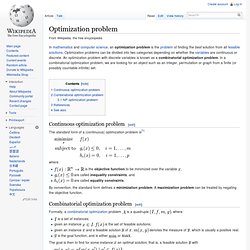

Optimization problem. Continuous optimization problem[edit] The standard form of a (continuous) optimization problem is[1] where is the objective function to be minimized over the variable , are called inequality constraints, and are called equality constraints.

By convention, the standard form defines a minimization problem. A maximization problem can be treated by negating the objective function. Combinatorial optimization problem[edit] Formally, a combinatorial optimization problem is a quadruple , where is a set of instances;given an instance , is the set of feasible solutions;given an instance and a feasible solution of , denotes the measure of , which is usually a positive real. is the goal function, and is either or .
The goal is then to find for some instance an optimal solution, that is, a feasible solution with For each combinatorial optimization problem, there is a corresponding decision problem that asks whether there is a feasible solution for some particular measure which contains vertices and to. Genetic programming. In artificial intelligence, genetic programming (GP) is an evolutionary algorithm-based methodology inspired by biological evolution to find computer programs that perform a user-defined task.
Essentially GP is a set of instructions and a fitness function to measure how well a computer has performed a task. It is a specialization of genetic algorithms (GA) where each individual is a computer program. It is a machine learning technique used to optimize a population of computer programs according to a fitness landscape determined by a program's ability to perform a given computational task. History[edit] In 1954, GP began with the evolutionary algorithms first used by Nils Aall Barricelli applied to evolutionary simulations.
In 1964, Lawrence J. In the 1990s, GP was mainly used to solve relatively simple problems because it is very computationally intensive. Developing a theory for GP has been very difficult and so in the 1990s GP was considered a sort of outcast among search techniques. Genetic algorithm. The 2006 NASA ST5 spacecraft antenna.

This complicated shape was found by an evolutionary computer design program to create the best radiation pattern. Genetic algorithms find application in bioinformatics, phylogenetics, computational science, engineering, economics, chemistry, manufacturing, mathematics, physics, pharmacometrics and other fields. Methodology[edit] In a genetic algorithm, a population of candidate solutions (called individuals, creatures, or phenotypes) to an optimization problem is evolved toward better solutions.
Each candidate solution has a set of properties (its chromosomes or genotype) which can be mutated and altered; traditionally, solutions are represented in binary as strings of 0s and 1s, but other encodings are also possible. A typical genetic algorithm requires: a genetic representation of the solution domain,a fitness function to evaluate the solution domain. Initialization of genetic algorithm[edit] Selection[edit] Genetic operators[edit] Termination[edit]
Evolutionary algorithm. Evolutionary algorithms often perform well approximating solutions to all types of problems because they ideally do not make any assumption about the underlying fitness landscape; this generality is shown by successes in fields as diverse as engineering, art, biology, economics, marketing, genetics, operations research, robotics, social sciences, physics, politics and chemistry[citation needed].

In most real applications of EAs, computational complexity is a prohibiting factor. In fact, this computational complexity is due to fitness function evaluation. Fitness approximation is one of the solutions to overcome this difficulty. However, seemingly simple EA can solve often complex problems; therefore, there may be no direct link between algorithm complexity and problem complexity. A possible limitation [according to whom?] Implementation of biological processes[edit] Evolutionary algorithm types[edit] Related techniques[edit] Swarm algorithms, including: